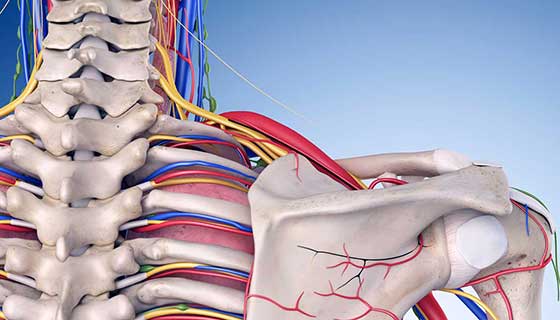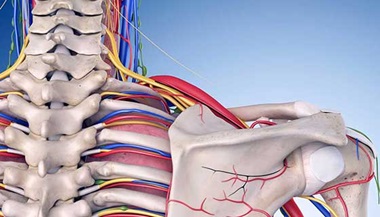Brachial Neuritis
What is brachial neuritis?
Brachial neuritis is a form of peripheral neuropathy that affects the nerves going to the chest, shoulder, arm, and hand. Peripheral neuropathy is a disease that causes pain or loss of function in the nerves that carry signals to and from the brain and spinal cord (the central nervous system) to other parts of the body. Brachial neuritis is a fairly rare condition.
Brachial neuritis is also referred to as brachial neuropathy or a brachial plexus injury. When acute brachial neuritis occurs, the damage to the brachial nerves comes on suddenly and unexpectedly. It isn't related to any other injury or health condition. This is also called Parsonage-Turner syndrome or neuralgic amyotrophy.
Brachial neuritis affects mainly the lower nerves of the brachial plexus, in the arm and hand. The brachial plexus is a bundle of nerves that travels from the spinal cord to the chest, shoulder, arms, and hands. This condition usually affects just one side of the body. But it can involve other nerves and other parts of the body as well.
What causes brachial neuritis?
In brachial neuritis, pain, loss of function, and other damage occur in the brachial plexus. This is the bundle of nerves that travels from the spinal cord to the chest, shoulder, arms, and hands.
Doctors don't know what causes brachial neuritis. It may be linked to an abnormal immune response from another illness or injury. But at other times, the pain and weakness from the disease occur without any reason.
What are the symptoms of brachial neuritis?
Symptoms of brachial neuritis include:
-
Severe pain in the upper arm or shoulder
-
Pain usually affecting just one side of the body
-
After a few hours or days, the pain transitions to weakness, limpness, or paralysis in the muscles of the affected arm or shoulder
-
Lack of muscle control in the shoulder or arm
-
Lack of sensation or feeling in the shoulder or arm
Symptoms typically go away slowly over the course of a few months or a few years.
How is brachial neuritis diagnosed?
Your healthcare provider will ask about your symptoms.
They may also do electromyography (EMG) or nerve conduction studies (NCS) to find out the specific nature and extent of the nerve damage. If your healthcare provider thinks that your pain might be from some other health problem, they may do more tests. These might include blood tests and Magnetic Resonance Imaging (MRI) of the brachial plexus.
How is brachial neuritis treated?
In some cases, acute brachial neuritis will go away on its own over time. Recovery can take 1 to 3 years. You may need:
-
Physical therapy to help preserve range of motion
-
Glucocorticoids (anti-inflammation steroids) may be given to reduce inflammation of the nerve.
-
Pain medicines, anti-seizure medicines, and antidepressant medicines may be used for nerve-related pain.
Can brachial neuritis be prevented?
Experts don’t know how to prevent brachial neuritis. The best thing you can do is avoid arm and shoulder injuries. But in a lot of cases, the cause is unknown. So there is little you can do to prevent it.
Living with brachial neuritis
In many cases, brachial neuritis will go away on its own after a few months. The best thing you can do is be patient. Also follow your healthcare provider's instructions to manage the severe pain of brachial neuritis.
Avoiding cigarettes and alcohol, eating a healthy diet, and getting regular exercise can help with various types of peripheral neuropathy. Brachial neuritis is no exception. In many cases, working with a physical therapist can help improve the condition.
Relaxation techniques such as yoga may also help ease emotional and physical symptoms. They can help you relieve stress naturally.
Key points about brachial neuritis
-
Brachial neuritis is a fairly rare condition. It causes pain and loss of muscle control in your shoulder or arm.
-
Medicines and therapy can help reduce pain and improve the condition.
Next steps
Tips to help you get the most from a visit to your healthcare provider:
-
Know the reason for your visit and what you want to happen.
-
Before your visit, write down questions you want answered.
-
Bring someone with you to help you ask questions and remember what your provider tells you.
-
At the visit, write down the name of a new diagnosis and any new medicines, treatments, or tests. Also write down any new instructions your healthcare provider gives you.
-
Know why a new medicine or treatment is prescribed and how it will help you. Also know what the side effects are.
-
Ask if your condition can be treated in other ways.
-
Know why a test or procedure is recommended and what the results could mean.
-
Know what to expect if you do not take the medicine or have the test or procedure.
-
If you have a follow-up appointment, write down the date, time, and purpose for that visit.
-
Know how you can contact your healthcare provider if you have questions.





